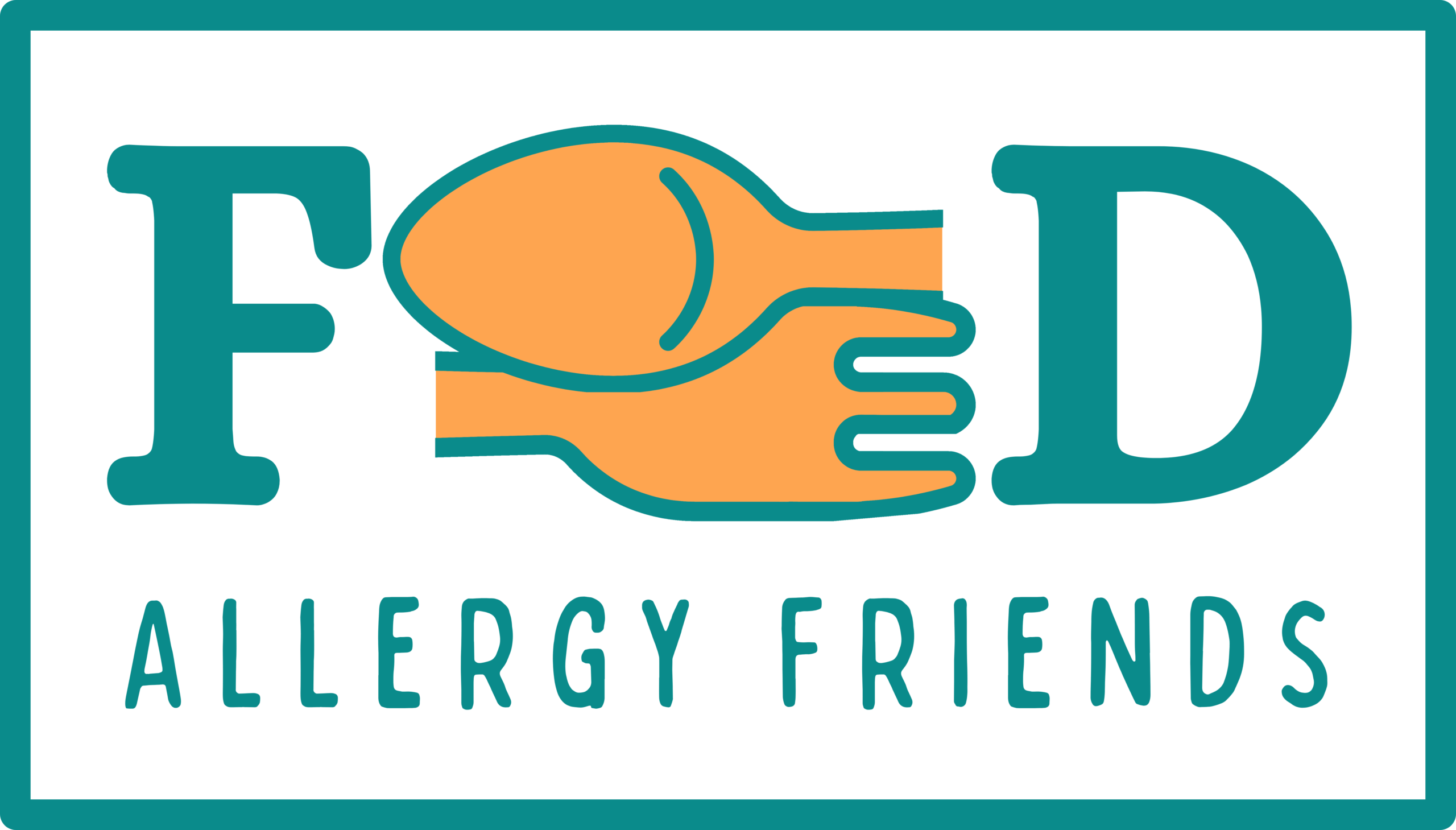About us
Why ‘Food Allergy Friends’?
 About Stella, the food allergic chef.
About Stella, the food allergic chef.
Having grown up with an allergy to egg, I often wonder how I ended up in the catering profession. I’ve been asked that question too many times to count. The reason was that I loved cookery at school, so I decided to go to catering college. As the years went by, I developed more food allergies, and ended up leaving the commercial kitchen in 2017.
I decided it was time to do something about the lack of understanding surrounding food allergies, and start teaching food safety and food allergen management, so Food Allergy Friends was born.
What do I do?
My aim is to remove the stigma and mystery from food allergies, intolerances, coeliac disease, and Eosinophilic Oesophagitis (EoE). I want to encourage food businesses to provide better, safer service for the food allergic customer, and show them that it’s not rocket science. Hence, my Cater Allergy Safer programmes and recognition.
With training and organisation, it is possible to give customers with special dietary needs accurate information, so they can make informed choices about where and what they eat, and provide them with safe food.
Those who live in fear of food, need support and confidence to ask about ingredients, not ridicule. Allergies are serious and life-threatening, and must be treated as such. Intolerances and coeliac disease can make people very ill, and need to be treated the same as allergies where meals are concerned.
This site is dedicated to helping everyone deal with food hypersensitivities. Whether you are preparing food at home, in a hotel, children’s nursery or care home, Food Allergy Friends is here to help you Cater Allergy Safer in every circumstance. Supporting you with tips, ideas, recipes, training, consultancy, a community, accreditation and much more.
For businesses
Food Allergy Friends Ltd is founded on over 40 years of experience in the hospitality industry, and a personal lifetime of dealing with food allergies. We have been registered as a Highfield Training Centre since 2021.
Through Food Allergy Friends, I can open up your understanding for those who have food hypersensitivities, such as allergies, intolerances, Coeliac disease, Crohn’s disease, IBS, Eosinophilic Oesophagitis, diabetes and more. I understand the trials and frustrations of both catering for special diets, and living on a very restricted diet, from my own first-hand experience.
My passion is to support food businesses through the minefield of food allergy, and so help the food hypersensitive diner to have confidence that they are safe. This is by sharing my experience (personal as well as professional) and knowledge through interactive courses. These are delivered via Zoom, at your own site, or at our training rooms in the Forest of Dean.
There is the potential to gain more customers by catering well for special dietary needs. Equally, it is possible to lose everything by getting it terribly wrong though complacency or misunderstanding. I believe no-one is better placed to guide you to delivering first class food safety.
The Cater Allergy Safer programmes and recognition scheme are your pathway to success.
- My business is your business.
- Helping you be the best you can.
- Keeping your customers safe.
- Showing the world you care.

As a Highfield Qualifications approved centre, all courses are Highfield accredited. This guarantees that your training is to the highest possible standard.
I hate food!
 ‘How can you be a chef, and hate food?’, I hear you say.
‘How can you be a chef, and hate food?’, I hear you say.
Well, when you’re allergic to onion and in a kitchen where someone is chopping onions, it’s a tad frightening. Or you don’t know if the next meal will bring you out in hives, make your skin itch like you’ve been thrown in a nettle bed, get stuck in your oesophagus, or even stop you breathing. It makes you not want to eat at all.
Eating socially just does not happen for many food allergy sufferers. It is just too scary when you can’t be certain of what’s in your food.
My life with EoE
I am married with a son, a daughter, and three grandsons. I am a qualified chef who happens to have food allergies, and a chronic condition called Eosinophilic Oesophagitis, shortened to EoE, which is also triggered by food and, in some cases, environmental triggers such as perfumes and air sprays.
It wasn’t until September 2016 that I got a diagnosis, at the age of 50, and after many years of arguing with Doctors, hospital consultants, and my family, and moving across the country.
What is EoE?
EoE is a rare condition where the white blood cells, known as Eosinophils, mistakenly attack the oesophagus when certain foods are eaten. Now, don’t think that eosinophils are bad, they are actually a valuable part of the immune system. Their job is to protect us from parasites and infections.
Eosinophils are produced in the bone marrow, and are normally found in the blood and in the lining of the gut. However, they are also associated with allergies. When they get out of control in the oesophagus, they can cause swelling, soreness, pain, difficulty swallowing, and damage, which may lead to being unable to eat any solid food and having to rely on tube feeding.
Many people who have this condition have been suffering for years without real help or diagnosis. EoE is often mistaken for, and treated as, heartburn, or acid reflux. The patient will be prescribed medication to reduce the amount of acid produced in the stomach. The symptoms are very similar, however, EoE does not always respond to this type of treatment, and other methods must be used.
EoE is indiscriminate, and can affect all ages, races, and genders. However, current statistics show that those most commonly affected are white males between the age of 30 and 50 years. There are many symptoms of EoE, including food refusal and failure to grow in young children, vomiting, chest pain, stomach pain, difficulty swallowing (dysphagia), and food impaction in the gullet.
Eosinophils can only be seen under a microscope, but the damage they can cause by being in the wrong place can make life very painful and difficult for sufferers.
Getting a diagnosis
 Due to the fact that EoE is a rare condition, and has only been classified since the 1990s, there are still a lot of doctors who haven’t heard of it. This means that sufferers have to keep going back, and pushing for tests.
Due to the fact that EoE is a rare condition, and has only been classified since the 1990s, there are still a lot of doctors who haven’t heard of it. This means that sufferers have to keep going back, and pushing for tests.
EoE can only be confirmed by endoscopy and biopsies, because eosinophils are not visible to the naked eye.
Treatment
The majority of patients will be prescribed medication such as Omeprazole or Lansopazole to reduce the amount of acid produced in the stomach. Steroids, such as Fluticasone, may be used in the form of an inhaler such as is used by asthma sufferers, but the ‘puff’ is not inhaled, rather swallowed to coat the oesophagus and reduce the inflammation and number of eosinophils.
There is also Budesonide, a steroid which is mixed into a ‘slurry’ and swallowed, with the same effect as the inhaler. More recently licenced in the UK is Jorveza, which is a tablet form of Budesonide, for adults to dissolve in the mouth. This has shown favourable results in trials, though we may have to wait some time to know more about it’s long term efficacy. From my understanding, Jorveza can only be prescribed for 6 weeks, then perhaps for further 6 weeks. We will not know yet how long symptoms will be kept at bay, or whether patients will be able to consume a normal diet.
Where did my journey begin?
I was born at home, the youngest of 5 girls, at 11:15 on 17 May. All my sisters were either at school or work, as there are 17 years between youngest and eldest. Very soon after my arrival, I was taken by ambulance, in an incubator, to hospital because I couldn’t feed. I don’t know what happened to me there. No-one can find any of my medical records from before 1982!
So, I have to rely on my sister to fill in the information. I am told that I was unable to feed, and that I was in hospital for 10 days. My mother had to stay at home, and I was visited by my sister, who brought milk that Mum had expressed. Bear in mind this was 1966, so refrigeration wasn’t as it is now, and it was an hour’s journey to the hospital, so who knows if I ever actually had my mother’s milk.
